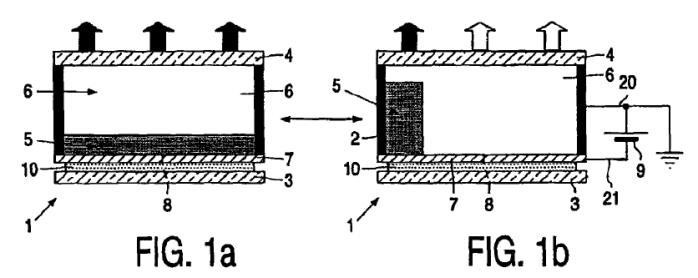Samsung’s recent acquisition of Liquavista (19/01/2011) is a significant step and indicates that the LCD giant is recognising that there are new technologies that will compete effectively with LCD for video colour displays. Liquavista were founded in 2006 as a spin-out from the Philips Research Labs and offer a new type of electronic display technology known as electrowetting for applications in e-readers, mobile phones, media players and other mobile devices. Electrowetting has been known for a while and is very effective in E-paper displays such as those used in the Amazon Kindle. These are black and white and so far there is no colour version available. Liquavista has been working away at this and believe they have cracked the problem with their latest technology.
I thought it would be useful to see what patents had been granted to Liquavista. A quick search reveals that there are many applications in the pipeline but relatively few of these have been granted. The most recent is US7800816 and is entitled: Display Device Based on Electrowetting Effect. It was granted on 21/09/2010 and was no doubt an important consideration in Samsung’s decision. The patent provides a technical description of the electrowetting effect and describes how this can be incorporated into a device for either reflective or transmissive displays. Figure 1 shows an individual display pixel or cell; in Figure 1a the cell is shown with no voltage applied – the display cell (which contains two immiscible fluids – one a black oil and the other a clear aqueous based fluid) does not reflect or transmit light as the oil is spread over the whole area of the cell. Figure 1b shows the state when a voltage is applied – here the black oil has moved aside due to electrostatic forces and light can be reflected or transmited.
By using a matrix of these pixels it is possible to create a display. The illustration uses a black oil but by using different dyes it is possible to create coloured oils for colour displays. A full explanation of this technology is given in the white paper provided by Liquavista (note: this is a large file and may take a while to open).
Claims 1-6 of the patent are as follows:
1. An optical switch comprising at least one first fluid (5) and a second fluid (6) immiscible with each other within a space between a first transparent support plate (3) and a second support plate (4), the second fluid being electroconductive or polar, the first fluid being an oil comprising a dye, the concentration of the dye being at most 0.2 M (mol/L).
2. An optical switch according to claim 1, the concentration of the dye being at most 0.1 M.
3. An optical switch according to claim 1, the concentration of the dye being at least 0.01 M.
4. An optical switch according to claim 1 in which the oil comprises at least one of the group silicone oil, hydrocarbon oil or fluorocarbon oil.
5. An optical switch according to claim 1 in which the first fluid has a Figure of Merit (FoM=ε.C) of at least 102 cm−1 in which ε is the extinction coefficient of the dye and C is the concentration of the dissolved dye in the first fluid.
6. A display device comprising picture elements having at least one first fluid and a second fluid immiscible with each other within a space between a first transparent support plate and a second support plate, the second fluid being electroconductive or polar, a picture element having an optical switch according to claim 1.
Hopefully this brief overview will provide some background to electrowetting and the value of patents in determining strategic business direction and success.
